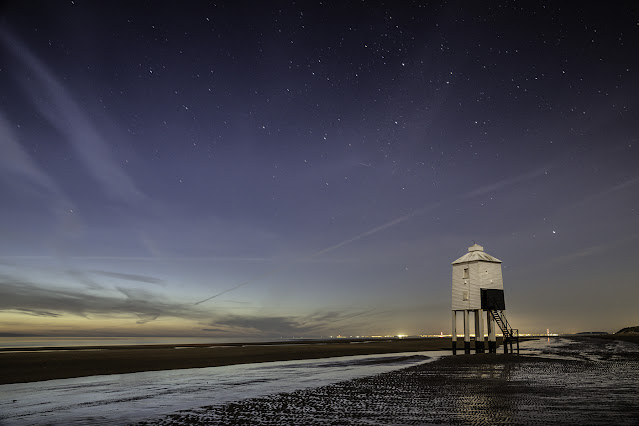Our chairperson reminded us about:
- Rugby photography, Saturday 3rd February
- Hare photography, Sunday 24th March.
Helen mentioned special offers on entry prices at Slimbridge Wildfowl Trust on Friday 2nd, Saturday 3rd and Sunday 4th February.
We then spent the rest of the evening listening to an excellent, thought-provoking and informative talk given by Tony Worobiec entitled "Low Light and Night Photography".
Pre-dawn
Tony recommended turning 180 degrees from the rising sun, which gives a view of the Venus Belt, an area of sky which varies from pink to blue. This can be rendered well in photos.
Rising mist is also visible, especially when there is high pressure and it has rained the night before. October to February works well for mist.

Corfe Castle, with the Venus Belt © Tony Worobiec
Dusk
Tony discussed using the moon to illuminate a scene (preferably nearly full, although 3/4 will do, from the side, out of shot).

Lighthouse, Burnham on Sea, by moonlight © Tony Worobiec
 |
| Horton Tower with moonlight © Tony Worobiec |
30 to 40 minutes after sunset, the light in the sky balances the light on the landscape. When looking south (in the northern hemisphere), star trails will be horizontal, when looking north they are the more characteristic circles centred on the Pole Star.
 |
| Balanced light and star trails looking north, Badlands, USA © Tony Worobiec |
For pin-sharp stars, either use a short exposure, or a tracking mount. A tracking mount will blur everything but the stars, so the scenery will require a separate shot, followed by some blending in your favourite image editor.
Tony mentioned the Milky Way starts the evening horizontally, then as the night passes becomes more perpendicular.
Crossover light
When photographing artificially illuminated buildings at night, the lighting on the building remains constant. To get a good balance between building and the sky behind it, wait for the sky to darken down. When they balance, this is known as "crossover" light. Also, don't worry about white balance, just leave it up to the camera.
Tony also mentioned - as he is local to it - Corfe Castle is illuminated at night around Christmas, ending in the first week of January.
Atmospheric decoupling
40 minutes after sunset, or 35 minutes before sunrise, when there is high pressure and no breeze, a phenomenon called "atmospheric decoupling" occurs. This will cause lakes to become mirror-flat, giving almost pefect reflections.
 |
| Bridge at Cordoba in crossover light with atmospheric decoupling © Tony Worobiec |
Tony then discussed how an 8 second exposure is needed for fireworks (any longer leads to confusing images), the usefulness of flash (not at full power), and Ulanzi lights which are relatively inexpensive and can be set to produce any desired colour.
He quickly took us through his fairground, cinema and neon images.

Fairground © Tony Worobiec
Our next meeting will be on 15th February.
